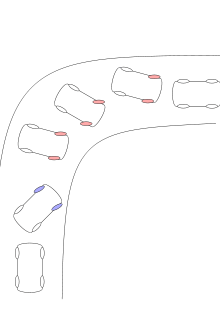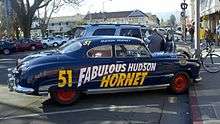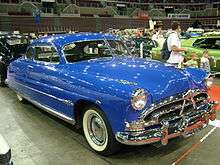Doc Hudson
| Doc Hudson | |
|---|---|
| Cars character | |
 | |
| First appearance |
The Incredibles (2004) (cameo) Cars (2006) |
| Last appearance | Cars 3 (2017) (flashback) |
| Created by | John Lasseter |
| Voiced by |
Paul Newman (first and third film, the first video game and Mater and the Ghostlight) Corey Burton (all other materials) |
| Based on | Fabulous Hudson Hornet of NASCAR |
| Information | |
| Nickname(s) | Hud (Smokey and Doc's old friends) |
| Species | Hudson Hornet motorcar |
| Gender | Male |
| Occupation | MD, judge, former racer |
| Title | Doc |
| Family | Mr. and Mrs. Hudson (deceased parents) |
| Nationality | American |
Doc Hudson (also known as The Fabulous Hudson Hornet or simply Doc) is an animated, anthropomorphic retired race car who appears in the 2006 Pixar film Cars as a medical doctor and a local judge.[1] He is voiced by actor Paul Newman in the first and third films and video game, and Corey Burton in all other media. Six-time Turismo Carretera champion Juan María Traverso voiced the character in the Rioplatense Spanish version of the first film. He is modeled after a 1951 Hudson Hornet.[2]
Character
Doc Hudson (Voiced by Paul Newman in his last non-documentary film role) was Radiator Springs' local physician. His license plate read 51HHMD which was a reference to his year and track number (51), model (Hudson Hornet) and profession (medical doctor). A racer-turned-mechanic, the character had Newman's blue eyes.[3]
Doc's stickers said "twin H power" which was an optional dealer-installed dual carburetor intake manifold, with twin 1-barrel carburetors and air filters. It was standard on 1952 model Hornets.[4] Doc was once known as the Fabulous Hudson Hornet (#51), one of the most famous race cars that ever lived. He won three consecutive Piston Cups (1951/52/53) and he still held the record for most wins in a single season (27, also the number of NASCAR Grand National races won by Hudson Hornets in 1952[5]). All of that changed for the famous Hornet when a terrible crash on the track during the final lap of the 1954 Piston Cup championship race saw him put out for the season in a career-ending injury which closely paralleled the fate of Herb Thomas, NASCAR's 1951 and 1953 champion. Upon his return, he was received with a complete absence of fanfare and told that he was passed up for the next rookie in line. He kept a newspaper article on the career-ending crash as a reminder to never return to the life that nearly killed him.
Jaded by the racing scene, he left that world, apparently taking out time to study medicine. The famous No. 51 disappeared into obscurity, leaving many wondering where he went. He instead opted for a simple navy blue paint job and the life of a physician in the tiny town of Radiator Springs, the "shining Gemstone" of the Mother Road – Route 66. He ran Doc's Clinic as a "doctor of Internal combustion". As times changed and the town was bypassed by Interstate 40, Doc stayed on, even when the population dwindled to a meager dozen residents. He was respected, well-loved and served not only as the town's physician, but as it’s judge. Nobody in the town had any idea of his past as a racer, knowing him merely as an ordinary Hudson Hornet and he used his Piston Cup trophies to hold his tools instead of putting them on display.

Upon meeting the rookie hotshot, Lightning McQueen after he got arrested for destroying the town's main street by accident, Doc saw far too much of the past that he left behind. His one token attempt to explain a controlled skid on an abrupt turn in dirt-track racing to Lightning was met with misunderstanding and skepticism, leaving Doc disillusioned and bitter about the young hot rod who seemed to care only about himself.
"This ain't asphalt, son. This is dirt. You don't have three-wheel brakes, so you got to pitch it hard, break it loose and then just drive it with the throttle. Give it too much, you'll be outta the dirt and into the tulips. I'll put it simple. If you're goin' hard enough left, you'll find yourself turnin' right."
— Doc Hudson explaining drifting to a skeptical McQueen
He was less than happy when an amazed McQueen discovered his past and asked, "How could a car like you quit at the top of your game?" Doc admitted that he did not quit, but was forced into retirement after his crash by the rise of hot young racers. "I had a lot of stuff left," Doc said sadly, "but I never got the chance to show it." After McQueen finished fixing the Radiator Springs road that he damaged when arriving in town as part of Doc’s court ruling, McQueen decided to stay in town for a while, but Doc was unable to bear having him around any longer and called the news and press, prompting McQueen to immediately leave for the Piston Cup championship race in California. But, seeing how disheartened that everyone was by the unplanned departure, Doc realized that Lightning became more important to them than he thought. His racing days are known to the town by now and he took back his #51 racing colors to become McQueen's pit crew chief. Nearly the entire town traveled to California as McQueen's pit crew and cheering section. At the race, the commentators recognized his presence on the cameras and Doc finally received a long-overdue acknowledgment for his return. When McQueen chose to help an injured Strip Weathers finish his last race instead of winning the Piston Cup, he expressed how proud he was of Lightning.
At the end of the film, Doc kept his racing colors, becoming a trainer as well as a friend to the young McQueen. Just like McQueen, Doc learned some lessons: Friendship, promises, how greed affected others and secrets could not be kept forever. When a racing museum subsequently opened in Radiator Springs, one entire wing was devoted to his racing career. Much as Junior #8 acknowledged to "The King" that "you've been an inspiration to me", The King indicated "the Hudson Hornet was my inspiration".
In the video game taking place after the first Cars film, he taught McQueen powerslide lessons and became the crew chief for McQueen during the Piston Cup season in the game's story mode. He was also a playable character who could be purchased by 5,000 points. Though during the game's story mode, he wore his original blue paint job and white wheels when racing McQueen or training him, but his original racing colors along with his red wheels could also be purchased.
In Cars 2, Doc dies before the events of the film and the Piston Cup was renamed in his honor and his clinic was converted into a museum that displayed trophies and mementos from his career.
John Lasseter announced that Cars 3 would include a tribute to Doc. McQueen's crash in the teaser was a reference to Doc's accident and he often recalled pieces of advice that Doc gave him in flashbacks. Lightning went to Doc's old trainer, Smokey in Thomasville, Georgia for help and watched movies of Doc's old races for inspiration. Smokey also explained that training Lightning, not racing, was the most enjoyable part of Doc's life. At the end, Lightning adopted Doc's old racing colors and painted "The Fabulous Lightning McQueen" on himself in honor of Doc, "The Fabulous Hudson Hornet." Lightning's bumper also read, "For Doc Hudson." Cruz Ramirez, a trainer who subsequently started a racing career of her own took on Doc's old number 51 as a second tribute.
Background

The car is based on the real-life Fabulous Hudson Hornet in NASCAR competition, with Doc's racing career most closely resembling that of Herb Thomas. Newman, a racing enthusiast and former driver, drew upon his experiences for the grumpy old race car's personality. The character has strong parallels to the Doc Hollywood of a 1991 film and shares the "Doc" moniker with the late Walter "Doc" Mason, interviewed on Route 66 as research for the film. A close friend of Michael Wallis (the voice of "Sheriff"), country veterinarian Dr. Walter S. Mason Jr. owned the Tradewinds Courtyard Inn from 1963 until 2003 and donated land for the Oklahoma Route 66 Museum in Clinton.[6] Doc Mason died in June 2007 after a lengthy battle with Alzheimer's disease.[7] After his demise the inn, which once hosted Elvis Presley[8] went into a steep decline, losing its Best Western membership and receiving many highly-negative reviews.[9]
The original Hudson Hornet was introduced in 1951 and manufactured until 1954. Fabulous Hudson Hornets won NASCAR cups for three consecutive years (Herb Thomas in 1951 and 1953, and Tim Flock in 1952), paralleling Doc Hudson's three Piston Cup wins in those same years. The Hudson Motor Company was merged into Nash Motors on January 14, 1954 to form American Motors Corporation (AMC). After brief use as a marque on Nash-designed AMC vehicles, the Hudson name disappeared entirely by 1957.[10] The automaker continued until its March 9, 1987 takeover by Chrysler, but never won another NASCAR championship cup.

The "Fabulous Hudson Hornet" name, which appeared on three famous NASCAR entries between 1951 and 1954, vanished once Hudson was merged into AMC. Herb Thomas #92 raced Buick and Chevrolet cars in 1955; severe injuries in a 1956 racing wreck in Shelby effectively ended his career, despite two unsuccessful starts in 1957 and one in 1962. Tim Flock #91 switched to Ford cars in 1955; he was one of two drivers forced out of NASCAR after supporting a 1961 unionisation attempt, the Federation of Professional Athletes. Marshall Teague #6 left NASCAR after the 1952 season in a dispute with NASCAR's owner Bill France, Sr.; he was killed in a 140-mile-per-hour (225 km/h) rollover collision at Daytona on February 11, 1959.
Doc Hudson does not appear in Cars 2 as his voice actor Paul Newman died from lung cancer in September 2008. Pixar decided having Doc appear in Cars 2 would not be a good idea.[11] A conversation between McQueen and Mater indicates that Doc died before the second film. Doc's memory lives on, as the Piston Cup was renamed after him. During the Japan leg of the World Grand Prix, one of the commentators notes that Doc was one of the best dirt-track racers of all time.
Herb Thomas' 1952 Fabulous Hudson Hornet is currently displayed in the Ypsilanti Automotive Heritage Museum in Michigan; Tim Flock's car is in the Memory Lane Museum in Mooresville, North Carolina. Herb Thomas entered NASCAR's hall of fame for 2013 as the first to win two NASCAR premier series championships (1951 and 1953).[12]
References
- ↑ Disney Pixar's The World of Cars: Meet the Cars. Disney Press. 2008. p. 10. ISBN 978-142311925-8.
He not only serves as the town judge, he's also Radiator Springs' resident doctor.
- ↑ Disney Pixar's The World of Cars: Meet the Cars. Disney Press. 2008. p. 10. ISBN 978-142311925-8.
- ↑ Fienberg, Daniel (11 June 2006). "With 'Cars', Paul Newman stayed in the race". The Post and Courier. p. 2H. Retrieved 26 December 2012.
- ↑ McCourt, Mark J. (August 2008). "Hudson Twin H-Power: With this dual-carburetor setup, from the street to the race track, Hudson proved that six was as mighty as eight". Hemmings Motor News. Retrieved 26 December 2012.
- ↑ Jack Nerad. "Hudson Hornet". Driving Today. Archived from the original on 25 October 2012. Retrieved 26 December 2012.
- ↑ Green, Gerald; Mason, Scott (22 June 2006). "Pixar's research visit to Clinton recalled". Clinton Daily News. Archived from the original on 28 October 2012. Retrieved 26 December 2012.
- ↑ Warnick, Ron (3 June 2007). "Former Best Western Trade Winds motel owner dies". Route 66 News. Retrieved 26 December 2012.
- ↑ sourbugger. "Best Western Trade Winds Courtyard Inn". Virtual Tourist. Retrieved 26 December 2012.
- ↑ "Trade Winds Inn (reviews)". tripadvisor.ca. Retrieved 26 December 2012.
- ↑ Blumberg, George (11 April 2003). "Driving; Hudsons Survive. The Dealer Does, Too". The New York Times. Retrieved 26 December 2012.
- ↑ Zeitchik, Steven (1 March 2011). "24 Frames: No Paul Newman or Doc Hudson in 'Cars 2' -- but watch for a tribute". Los Angeles Times. Retrieved 26 December 2012.
- ↑ Jensen, Tom (23 May 2012). "NHOF: Herb Thomas Heads 2013 Hall Class". Speed TV. Archived from the original on 4 February 2013. Retrieved 26 December 2012.